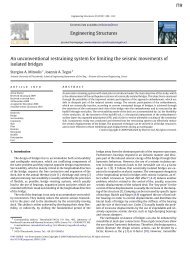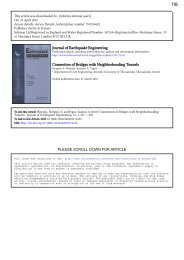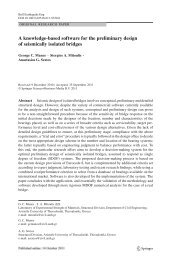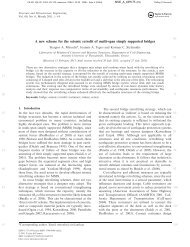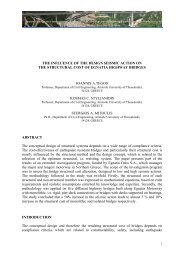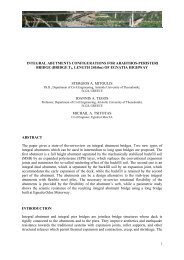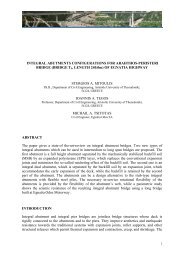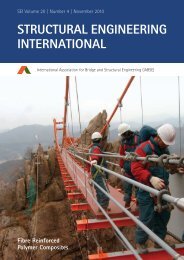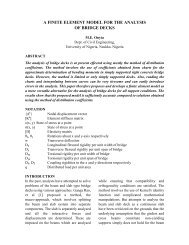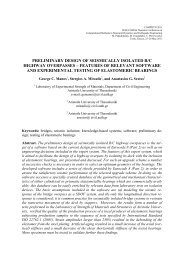20 An alternative proposal for the design of balanced cantilever bridges with small span lengths KEIMENO
You also want an ePaper? Increase the reach of your titles
YUMPU automatically turns print PDFs into web optimized ePapers that Google loves.
IBSBI <strong>20</strong>11, October 13-15, <strong>20</strong>11, A<strong>the</strong>ns, Greece<br />
AN ALTERNATIVE PROPOSAL FOR THE DESIGN OF<br />
BALANCED CANTILEVER BRIDGES WITH SMALL<br />
SPAN LENGTHS<br />
Ioannis A. Tegos 1 and Stergios A. Mitoulis 2<br />
1,2 Aristotle University <strong>of</strong> Thessaloniki, Dept. <strong>of</strong> Civil Engineering, Greece<br />
e-mail: itegos@civil.auth.gr, mitoulis@civil.auth.gr<br />
ABSTRACT: In <strong>balanced</strong> <strong>cantilever</strong> structural method <strong>the</strong> prestressing is<br />
utilised as means to control <strong>the</strong> strains and to rein<strong>for</strong>ce <strong>the</strong> top flange <strong>of</strong> <strong>the</strong><br />
deck’s cross section at <strong>the</strong> supports. Ordinary strength rein<strong>for</strong>cements are<br />
typically applied <strong>with</strong>in <strong>the</strong> bottom flange <strong>of</strong> <strong>the</strong> deck, after accounting <strong>for</strong> <strong>the</strong><br />
unfavorable participation <strong>of</strong> <strong>the</strong> prestress. The last check is a critical one at <strong>the</strong><br />
<strong>balanced</strong> <strong>cantilever</strong>-method. Thus <strong>the</strong> use <strong>of</strong> ordinary rein<strong>for</strong>cements at <strong>the</strong><br />
bottom flange <strong>of</strong> <strong>balanced</strong> <strong>cantilever</strong>s, namely <strong>the</strong> avoidance <strong>of</strong> prestressing<br />
tendons, seems to be an interesting <strong>design</strong> <strong>alternative</strong> which ensures a better<br />
construction result. <strong>An</strong> analytical study on this <strong>design</strong> <strong>alternative</strong> had been<br />
carried out <strong>for</strong> <strong>cantilever</strong> <strong>bridges</strong> <strong>of</strong> relatively <strong>small</strong> <strong>span</strong> <strong>lengths</strong> actually built<br />
along <strong>the</strong> Egnatia Highway in Thrace.<br />
KEY WORDS: Bridge; Balanced Cantilever; Small Span; Design; Ordinary<br />
Strength Steel (OSS).<br />
1 INTRODUCTION<br />
Safety, serviceability, cost-effectiveness, aes<strong>the</strong>tics and particular technical<br />
issues are typically <strong>the</strong> controlling factors in <strong>the</strong> selection <strong>of</strong> <strong>the</strong> proper bridge<br />
type [1] [2] and construction method. In many cases, a prestressed bridge is a<br />
cost-effective choice. Typically, segmental concrete bridge construction is<br />
utilized, which is <strong>the</strong> most common method <strong>of</strong> bridge construction.<br />
Segmental construction method typically introduces: (a) <strong>the</strong> conventional castin-situ<br />
bridge construction, (b) <strong>the</strong> precast prestressed I-beam deck construction<br />
<strong>with</strong> continuous cast-in-situ slab decks, (c) <strong>the</strong> <strong>balanced</strong> <strong>cantilever</strong> bridge<br />
construction, which ei<strong>the</strong>r utilises scaffolding or precast deck segments and (d)<br />
<strong>the</strong> progressive and <strong>span</strong> by <strong>span</strong> incrementally launched bridge construction.<br />
Segmental cast-in-situ bridge construction is preferable in case <strong>of</strong> straight and<br />
curved in plan <strong>bridges</strong> <strong>with</strong> relatively <strong>small</strong> bent heights and when prestressing<br />
is applied in <strong>the</strong> longitudinal direction <strong>of</strong> <strong>the</strong> superstructure, as shown in Figure<br />
1. The <strong>for</strong>mworks are typically supported directly to <strong>the</strong> ground or to a well<br />
compacted temporary embankment. In most cases, <strong>the</strong> first <strong>span</strong> and a 15 to
2 Proceedings IBSBI <strong>20</strong>11<br />
<strong>20</strong>% <strong>of</strong> <strong>the</strong> length <strong>of</strong> <strong>the</strong> second <strong>span</strong> are casted toge<strong>the</strong>r. The construction <strong>of</strong><br />
<strong>the</strong> next bridge segment follows after <strong>the</strong> application <strong>of</strong> <strong>the</strong> prestressing <strong>for</strong>ce,<br />
while keeping <strong>the</strong> immediate prestress losses <strong>with</strong>in normal levels. The final<br />
loading <strong>of</strong> <strong>the</strong> bridge due to <strong>the</strong> self-weight <strong>of</strong> <strong>the</strong> superstructure is varying <strong>with</strong><br />
time due to <strong>the</strong> influence <strong>of</strong> <strong>the</strong> creep effect [3] [4].<br />
A new bridge construction method is investigated in this paper. The method has<br />
similarities <strong>with</strong> <strong>the</strong> <strong>balanced</strong> <strong>cantilever</strong> method. The connection <strong>of</strong> <strong>the</strong><br />
<strong>cantilever</strong>s is achieved by <strong>the</strong> use <strong>of</strong> tendon couplers. The tendons are straight<br />
and <strong>the</strong> scaffolding, which is used <strong>for</strong> <strong>the</strong> deck casting, is removed after <strong>the</strong><br />
application <strong>of</strong> <strong>the</strong> prestressing <strong>for</strong>ce. The applicability <strong>of</strong> <strong>the</strong> proposed<br />
construction method has been attempted to a cast-in-situ benchmark bridge<br />
actually built along a major motorway that runs across Nor<strong>the</strong>rn Greece.<br />
2 THE PROPOSED CONSTRUCTION METHOD<br />
2.1 Structural assumptions<br />
The proposed structural method, which can be utilised <strong>for</strong> <strong>the</strong> construction <strong>of</strong><br />
cast-in-situ <strong>bridges</strong>, is based on <strong>the</strong> following structural assumptions: (a) The<br />
deck cross section has a variable height along <strong>the</strong> longitudinal direction <strong>of</strong> <strong>the</strong><br />
bridge <strong>with</strong> a symmetrical bottom flange, which is modulated by a polygonal<br />
shape inscribed in a parabolic arch, as shown in Figure 1. The cross section <strong>of</strong><br />
<strong>the</strong> deck can be ei<strong>the</strong>r a box girder or a voided slab. (b) The prestressing<br />
tendons are straight and continuous in all <strong>the</strong> deck <strong>span</strong>s and <strong>the</strong>y are installed<br />
in <strong>the</strong> top flange <strong>of</strong> <strong>the</strong> deck. The appropriate concrete cover [5] [6] is provided<br />
to protect <strong>the</strong> tendons against corrosion. Within <strong>the</strong> bottom flange <strong>of</strong> <strong>the</strong> deck<br />
only ordinary strength steel is utilised. (c) The construction <strong>of</strong> <strong>the</strong> end <strong>span</strong>s can<br />
follow two different <strong>design</strong> <strong>alternative</strong>s: (c 1 ) The first <strong>alternative</strong> introduces <strong>the</strong><br />
construction <strong>of</strong> <strong>the</strong> end <strong>span</strong>s by maintaining <strong>the</strong> geometry <strong>of</strong> <strong>the</strong> intermediate<br />
<strong>span</strong>s <strong>for</strong> reasons <strong>of</strong> aes<strong>the</strong>tics. In that case, <strong>the</strong> deck is chosen to be seated on a<br />
wall-like abutment web, as shown in Figure 1 and 2. (c 2 ) The second <strong>design</strong><br />
<strong>alternative</strong> introduces <strong>the</strong> construction <strong>of</strong> <strong>the</strong> end <strong>span</strong>s <strong>with</strong> <strong>lengths</strong> <strong>small</strong>er<br />
than <strong>the</strong> ones <strong>of</strong> <strong>the</strong> intermediate ones. Half <strong>of</strong> <strong>the</strong> length <strong>of</strong> <strong>the</strong> end <strong>span</strong> has a<br />
deck cross section <strong>with</strong> variable height. This corresponds to <strong>the</strong> part <strong>of</strong> <strong>the</strong> deck<br />
which extends from <strong>the</strong> end pier towards <strong>the</strong> abutment. The o<strong>the</strong>r part <strong>of</strong> <strong>the</strong><br />
<strong>span</strong> is seated through bearings to <strong>the</strong> abutment, as shown on <strong>the</strong> right abutment<br />
<strong>of</strong> Figure 1. It extends from <strong>the</strong> abutment towards <strong>the</strong> pier and has a constant<br />
cross section height. The need <strong>for</strong> <strong>the</strong> <strong>small</strong>er length <strong>of</strong> <strong>the</strong> end <strong>span</strong>s was found<br />
to be dictated by <strong>the</strong> relatively <strong>small</strong> height <strong>of</strong> <strong>the</strong> deck cross section that is 0,80<br />
m and by <strong>the</strong> use <strong>of</strong> ordinary rein<strong>for</strong>cements in <strong>the</strong> bottom fibre <strong>of</strong> <strong>the</strong> deck.<br />
It is noted that <strong>the</strong> use <strong>of</strong> prestressing <strong>with</strong>in <strong>the</strong> bottom flange <strong>of</strong> <strong>the</strong> deck was<br />
not deemed to be a rational <strong>design</strong> selection, as <strong>the</strong> tendons would induce a<br />
large vertical load downwards, due to <strong>the</strong> variation <strong>of</strong> <strong>the</strong> height <strong>of</strong> <strong>the</strong> deck<br />
cross section. This constraint loading, namely <strong>the</strong> one induced by possible
I.A. Tegos and S.A. Mitoulis 3<br />
negative prestressing, would not be compatible <strong>with</strong> <strong>the</strong> rational use <strong>of</strong> tendons,<br />
which are typically utilised in order to compensate <strong>for</strong> <strong>the</strong> vertical loading.<br />
a-a<br />
a<br />
a<br />
h2=0,80m<br />
h1=2.<strong>20</strong>m<br />
b-b<br />
P1<br />
b<br />
b<br />
c-c<br />
centre <strong>of</strong> gravity<br />
<strong>of</strong> <strong>the</strong> deck<br />
h3=0,80m<br />
c<br />
c<br />
A1<br />
bearing<br />
a<br />
a<br />
c<br />
c<br />
A2<br />
Figure 1. The first stage <strong>of</strong> <strong>the</strong> proposed construction method <strong>with</strong> <strong>alternative</strong> abutment<br />
configurations.<br />
2.2 Particular <strong>design</strong> issues<br />
Τhe rigid connection <strong>of</strong> <strong>the</strong> deck <strong>with</strong> <strong>the</strong> abutments was achieved by <strong>the</strong><br />
construction <strong>of</strong> a counterbalance that is a <strong>cantilever</strong> which extends from <strong>the</strong><br />
abutment towards <strong>the</strong> backfill soil, as shown in Figure 1 and 2. The length <strong>of</strong><br />
this <strong>cantilever</strong> is 5,0 m and its cross section height reduces from <strong>the</strong> abutment to<br />
<strong>the</strong> backfill. The end cross section <strong>of</strong> <strong>the</strong> <strong>cantilever</strong> is utilised <strong>for</strong> <strong>the</strong> anchorage<br />
<strong>of</strong> <strong>the</strong> tendons. The tendons are slightly lowered at <strong>the</strong>ir anchorages in order to<br />
provide <strong>the</strong> appropriate cover <strong>for</strong> <strong>the</strong>ir anchoring devices, namely <strong>the</strong> bearing<br />
plates. A structural tie, namely a rein<strong>for</strong>ced concrete wall <strong>with</strong> a thickness <strong>of</strong><br />
0,30 m, is utilized in order to receive <strong>the</strong> bending moments <strong>of</strong> <strong>the</strong><br />
counterbalance-<strong>cantilever</strong>, which are developed due to <strong>the</strong> vertical loading <strong>of</strong><br />
<strong>the</strong> deck. In fact this wall, namely <strong>the</strong> structural tie, is under tension, while <strong>the</strong><br />
abutment web, which receives <strong>the</strong> vertical loading through <strong>the</strong> bearings, is<br />
under compression. The structural tie has a transverse dimension equal to <strong>the</strong><br />
distance between <strong>the</strong> wing walls, <strong>with</strong> which it is in contact but not connected.<br />
The rein<strong>for</strong>cement bars <strong>of</strong> <strong>the</strong> structural tie are anchored in <strong>the</strong> pile cap <strong>of</strong> <strong>the</strong><br />
abutment’s foundation. This pile cap has a relatively <strong>small</strong> thickness, as <strong>the</strong><br />
wing walls and <strong>the</strong> wall that retains <strong>the</strong> backfill soil <strong>for</strong>mulate a stiff concrete<br />
“box”, which increases <strong>the</strong> stiffness <strong>of</strong> <strong>the</strong> pile cap. In case <strong>the</strong> web is integral<br />
<strong>with</strong> <strong>the</strong> deck, its in-service constrained movements can be accommodated by<br />
subdividing it in walls.
4 Proceedings IBSBI <strong>20</strong>11<br />
backfill<br />
inspection<br />
opening<br />
lowered<br />
tendons<br />
(Detail)<br />
counterbalance<br />
<strong>cantilever</strong><br />
straight<br />
tendons<br />
bearing<br />
retaining<br />
wall<br />
structural<br />
tie<br />
Detail<br />
2,75<br />
2,75<br />
pile cap<br />
R=30m<br />
450mm<br />
Figure 2. The abutment <strong>of</strong> <strong>the</strong> proposed construction method.<br />
R=30m<br />
150mm<br />
The minimum height <strong>of</strong> <strong>the</strong> deck cross section is proposed to be not <strong>small</strong>er<br />
than 0,80 m. After <strong>the</strong> curing <strong>of</strong> <strong>the</strong> casted <strong>cantilever</strong>s, <strong>the</strong> tendons are stressed.<br />
The <strong>design</strong> <strong>of</strong> <strong>the</strong> prestressing <strong>for</strong>ce is based on <strong>the</strong> objective <strong>of</strong> <strong>the</strong> method that<br />
is to provide a slight pre-cambering <strong>of</strong> <strong>the</strong> <strong>cantilever</strong>s that is a slight bending<br />
deflection upwards. There<strong>for</strong>e, at this stage <strong>the</strong> <strong>cantilever</strong>s <strong>of</strong> <strong>the</strong> deck are set<br />
higher than <strong>the</strong> final <strong>design</strong> height <strong>of</strong> <strong>the</strong> bridge. After <strong>the</strong> application <strong>of</strong><br />
prestressing, <strong>the</strong> steel <strong>for</strong>mwork is removed and <strong>the</strong> construction procedure is<br />
repeated <strong>for</strong> <strong>the</strong> adjacent <strong>span</strong>s. The tendons <strong>of</strong> <strong>the</strong> subsequent <strong>span</strong>s are<br />
coupled <strong>with</strong> <strong>the</strong> ones <strong>of</strong> <strong>the</strong> casted <strong>cantilever</strong> and <strong>the</strong> adjacent <strong>cantilever</strong> is<br />
constructed. A detailed description <strong>of</strong> <strong>the</strong> prestressing application and <strong>the</strong> rebar<br />
<strong>of</strong> <strong>the</strong> deck is given in section 3 <strong>of</strong> <strong>the</strong> paper.<br />
After <strong>the</strong> completion <strong>of</strong> <strong>the</strong> deck construction and <strong>the</strong> application <strong>of</strong> <strong>the</strong><br />
prestressing <strong>for</strong>ce, positive bending moments, which are caused due to <strong>the</strong><br />
eccentricity <strong>of</strong> <strong>the</strong> straight tendons from <strong>the</strong> deck’s centre <strong>of</strong> gravity, are<br />
induced along <strong>the</strong> deck. These positive bending moments overbalance <strong>the</strong><br />
negative ones that are imposed by <strong>the</strong> self-weight <strong>of</strong> <strong>the</strong> deck. Hence, <strong>the</strong><br />
a<strong>for</strong>ementioned pre-cambering <strong>of</strong> <strong>the</strong> <strong>cantilever</strong>s is achieved. The precambering<br />
was deemed necessary in order to compensate <strong>for</strong> <strong>the</strong> pre-determined<br />
long-term prestress losses due to <strong>the</strong> creep and shrinkage <strong>of</strong> <strong>the</strong> deck and due to<br />
<strong>the</strong> relaxation <strong>of</strong> prestressing steel. The rest <strong>of</strong> <strong>the</strong> vertical loads <strong>of</strong> <strong>the</strong> deck that<br />
are <strong>the</strong> additional permanent and <strong>the</strong> variable loading [7] are imposed after <strong>the</strong><br />
completion <strong>of</strong> <strong>the</strong> total bridge system. Thus, <strong>the</strong> frame action <strong>of</strong> <strong>the</strong> total bridge<br />
structure, in which <strong>the</strong> meeting <strong>cantilever</strong>s are connected, receives <strong>the</strong><br />
additional vertical loading. The final bridge system is <strong>the</strong>n checked against <strong>the</strong><br />
resulting bending moments, <strong>the</strong> shear actions and <strong>the</strong> torsion effects after<br />
considering <strong>the</strong> re-distribution <strong>of</strong> actions. In particular, <strong>the</strong> <strong>design</strong> <strong>of</strong> <strong>the</strong> deck<br />
against shear actions is facilitated due to <strong>the</strong> beneficial inclination to <strong>the</strong><br />
horizontal <strong>of</strong> <strong>the</strong> compression zone <strong>of</strong> <strong>the</strong> deck in <strong>the</strong> critical section <strong>for</strong> shear,<br />
namely where <strong>the</strong> maximum shear stress is acting. Possible deficiency <strong>of</strong> <strong>the</strong><br />
deck at <strong>the</strong> supports against <strong>the</strong> bending moments caused by ei<strong>the</strong>r <strong>the</strong> ultimate<br />
or <strong>the</strong> serviceability limit states [6] [8] shall be covered by additional
I.A. Tegos and S.A. Mitoulis 5<br />
rein<strong>for</strong>cement bars <strong>of</strong> ordinary strength steel. The additional rein<strong>for</strong>cements<br />
cover <strong>the</strong> safety criteria set by codes [6] [8] and <strong>the</strong> serviceability requirements<br />
by limiting <strong>the</strong> crack width according to <strong>the</strong> code provisions [5] [6].<br />
3 APPLICATION OF THE CONSTRUCTION METHOD TO A<br />
CAST-IN-SITU BRIDGE<br />
3.1 Description <strong>of</strong> <strong>the</strong> benchmark bridge<br />
The bridge <strong>of</strong> Kleidi-Kouloura belongs to Egnatia Motorway that runs across<br />
Nor<strong>the</strong>rn Greece. It is a cast-in-situ structure <strong>with</strong> a total <strong>of</strong> three <strong>span</strong>s and a<br />
total length equal to 135.8 m. More details on <strong>the</strong> bridge are given in an ano<strong>the</strong>r<br />
paper <strong>of</strong> IBSBI <strong>20</strong>11 conference.<br />
3.2 Results<br />
The benchmark bridge was re-analysed and re-<strong>design</strong>ed according to current<br />
code provisions concerning serviceability [6] [8] and earthquake resistance [9].<br />
The re-<strong>design</strong> took into account <strong>the</strong> construction phases <strong>of</strong> <strong>the</strong> proposed method<br />
and <strong>the</strong> following predominant <strong>design</strong> parameters were revealed:<br />
(1) The required number <strong>of</strong> straight tendons was less than <strong>the</strong> one needed in<br />
case a classification category A or B was chosen, (table 4.118 in [6] [8]).<br />
However, <strong>the</strong> total number <strong>of</strong> tendons ensures that <strong>the</strong> bridge is classified in<br />
category C, when this requirement refers to <strong>the</strong> per<strong>for</strong>mance <strong>of</strong> <strong>the</strong> top fibre <strong>of</strong><br />
<strong>the</strong> deck, while <strong>the</strong> use <strong>of</strong> ordinary strength rein<strong>for</strong>cements in <strong>the</strong> bottom fibre<br />
<strong>of</strong> <strong>the</strong> deck leads to <strong>the</strong> classification category D. It is noted that, <strong>the</strong> <strong>design</strong> <strong>of</strong><br />
<strong>the</strong> prestressing <strong>for</strong>ce and <strong>the</strong> resulting number <strong>of</strong> tendons aims at providing <strong>the</strong><br />
required pre-cambering <strong>of</strong> <strong>the</strong> <strong>cantilever</strong>s against <strong>the</strong> self weight <strong>of</strong> <strong>the</strong> bridge<br />
deck, whose length was half <strong>of</strong> <strong>the</strong> total <strong>span</strong> length that is 45,60/2 = 22,80 m.<br />
(2) The re-<strong>design</strong> <strong>of</strong> <strong>the</strong> prestressing showed that 15x19T15 (15 tendons <strong>of</strong> 19<br />
wires <strong>with</strong> diameter 15mm each) <strong>of</strong> high strength steel St 1500/1770 are<br />
adequate to receive <strong>the</strong> bending moment <strong>of</strong> <strong>the</strong> deck above its support.<br />
Additionally, ordinary steel rebar 76Ø16 (76 bars <strong>with</strong> diameter 16mm each)<br />
above <strong>the</strong> support were utilized, which gradually reduced to 28Ø16 at <strong>the</strong> bridge<br />
mid-<strong>span</strong>. The tendons and <strong>the</strong> rein<strong>for</strong>cements needed in <strong>the</strong> top flange <strong>of</strong> <strong>the</strong><br />
deck are illustrated in Figure 3. The ordinary strength steel bars, which are also<br />
required by <strong>the</strong> code [6], are <strong>the</strong> ones which allow <strong>the</strong> safe transition from <strong>the</strong><br />
uncracked to <strong>the</strong> cracked deck section and <strong>the</strong> avoidance <strong>of</strong> non-ductile failure<br />
modes. The <strong>lengths</strong> <strong>of</strong> <strong>the</strong> steel bars were chosen to be sub-multiples, namely<br />
half, <strong>of</strong> <strong>the</strong> conventionally produced ones by <strong>the</strong> steel manufactures in order to<br />
avoid material waste. Figures 4 and 5 show in detail <strong>the</strong> rein<strong>for</strong>cement layout at<br />
<strong>the</strong> support and at <strong>the</strong> mid-<strong>span</strong>. Figure 6 shows <strong>the</strong> steel rebar <strong>of</strong> <strong>the</strong> bottom<br />
part <strong>of</strong> <strong>the</strong> deck. The bars are installed in couples that are 2x71Ø25 (71 couples<br />
<strong>of</strong> bars <strong>with</strong> diameters 25mm each) at <strong>the</strong> mid-<strong>span</strong>, while 2x41Ø25 were found<br />
to be required at <strong>the</strong> bottom flange <strong>of</strong> <strong>the</strong> deck at <strong>the</strong> supports. The
6 Proceedings IBSBI <strong>20</strong>11<br />
rein<strong>for</strong>cement splices were required to extend 2,15 m. The <strong>lengths</strong> <strong>of</strong> <strong>the</strong> bars<br />
were selected to be 7,0 m and <strong>the</strong>y were set parallel to <strong>the</strong> sides <strong>of</strong> <strong>the</strong> polygonal<br />
shape <strong>of</strong> <strong>the</strong> bottom flange, as shown in Figure 6. (4) The thickness and <strong>the</strong><br />
rein<strong>for</strong>cement <strong>of</strong> <strong>the</strong> structural tie, that is <strong>the</strong> wall that restrains <strong>the</strong> vertical<br />
movements <strong>of</strong> <strong>the</strong> counterbalance-<strong>cantilever</strong> at <strong>the</strong> abutment shown in Figure 1<br />
and 2, were found to be 0,30m and 3xØ16/100 (3 lines <strong>of</strong> bars <strong>with</strong> diameter<br />
16mm at a spacing 100 mm) correspondingly.<br />
Pier<br />
Y<br />
X<br />
28O16<br />
L=14,0m<br />
52O16<br />
L=7,0m<br />
76O16<br />
L=14,0m<br />
52O16<br />
L=7,0m<br />
28O16<br />
L=14,0 m<br />
lapping<br />
3,50 m<br />
couplers<br />
tendons 15x19T15 (St 1500/1770)<br />
Figure 3. The layout <strong>of</strong> <strong>the</strong> straight tendons and <strong>the</strong> ordinary strength steel bars <strong>of</strong> <strong>the</strong> deck’s top<br />
flange at <strong>the</strong> support, (<strong>the</strong> scale is distorted: 1 unit at X equals 2 units at Y axis).<br />
Pier<br />
7,00 7,00<br />
8,50 5,50<br />
5,50 8,50<br />
1,00<br />
L=14,0 m<br />
tendons<br />
Figure 4. Detail <strong>of</strong> <strong>the</strong> straight tendons and <strong>the</strong> ordinary strength steel bars <strong>of</strong> <strong>the</strong> deck’s top<br />
flange at <strong>the</strong> support.
I.A. Tegos and S.A. Mitoulis 7<br />
lapping<br />
14,00 3,52<br />
7,00<br />
7,00<br />
couplers<br />
tendons<br />
structural joint<br />
Figure 5. Detail <strong>of</strong> <strong>the</strong> ordinary strength steel bars <strong>of</strong> <strong>the</strong> deck’s top flange at <strong>the</strong> mid-<strong>span</strong> and<br />
coupling <strong>of</strong> <strong>the</strong> tendons.<br />
~4,50m<br />
2,0-2,50m<br />
top flange<br />
straight tendons<br />
15x19T15 (St 1500/1770)<br />
d=150mm<br />
d>150mm<br />
pier<br />
2,15m 7,0m 7,0m<br />
7,0m<br />
2X51Φ25<br />
2X51Φ25<br />
2X41Φ25<br />
splicing<br />
polygonal<br />
length<br />
bottom<br />
flange<br />
corners <strong>of</strong> <strong>the</strong> polygon<br />
2X61Φ25<br />
2X71Φ25<br />
mid-<strong>span</strong><br />
structural joint<br />
l=35,0-50,0m<br />
Figure 6. Detail <strong>of</strong> <strong>the</strong> ordinary strength steel bars at <strong>the</strong> bottom flange <strong>of</strong> <strong>the</strong> deck.<br />
4 CONCLUSIONS<br />
This paper proposes a new bridge construction method, which can be used as a<br />
<strong>design</strong> <strong>alternative</strong> to <strong>the</strong> conventional construction practices. The method has<br />
many similarities <strong>with</strong> <strong>the</strong> <strong>balanced</strong> <strong>cantilever</strong> method. The prestressing tendons<br />
are straight and installed <strong>with</strong>in <strong>the</strong> top flange <strong>of</strong> <strong>the</strong> deck cross section, while<br />
ordinary strength steel is utilized <strong>for</strong> <strong>the</strong> rein<strong>for</strong>cement <strong>with</strong>in <strong>the</strong> bottom<br />
flange. The deck has a variable cross section height along its longitudinal<br />
direction. A benchmark bridge, actually built along <strong>the</strong> Egnatia Motorway by<br />
<strong>the</strong> conventional segmental cast-in-situ method, was utilized to identify <strong>the</strong><br />
applicability <strong>of</strong> <strong>the</strong> proposed method. The bridge was checked according to <strong>the</strong><br />
current code provisions and <strong>the</strong> study came up <strong>with</strong> <strong>the</strong> following findings:<br />
• The application <strong>of</strong> <strong>the</strong> proposed construction method revealed significant<br />
structural benefits. The use <strong>of</strong> straight tendons <strong>for</strong> <strong>the</strong> prestressing <strong>of</strong> <strong>the</strong><br />
deck facilitates and accelerates <strong>the</strong> construction <strong>of</strong> <strong>the</strong> bridge. The tendons<br />
are installed <strong>with</strong>in <strong>the</strong> upper slab <strong>of</strong> <strong>the</strong> deck’s cross section, which is more<br />
preferable than using tendons which are installed in <strong>the</strong> webs <strong>of</strong> <strong>the</strong> box<br />
girder. It is noted that <strong>the</strong> use <strong>of</strong> tendons in <strong>the</strong> webs <strong>of</strong> <strong>the</strong> box-girder decks<br />
is not allowed according to current code <strong>design</strong>, at least <strong>for</strong> <strong>bridges</strong><br />
constructed by <strong>the</strong> <strong>balanced</strong> <strong>cantilever</strong> method. Fur<strong>the</strong>rmore, <strong>the</strong> prestressing<br />
losses due to friction are significantly reduced when <strong>the</strong> proposed
8 Proceedings IBSBI <strong>20</strong>11<br />
construction method is employed. The dead load <strong>of</strong> <strong>the</strong> bridge deck, which<br />
typically constitutes <strong>the</strong> largest portion <strong>of</strong> <strong>the</strong> bridge’s vertical loading, is<br />
decreased due to <strong>the</strong> reduction in <strong>the</strong> height <strong>of</strong> <strong>the</strong> deck cross section.<br />
However, <strong>the</strong> variation <strong>of</strong> <strong>the</strong> deck cross section along <strong>the</strong> bridge deck<br />
obstructs <strong>the</strong> falsework as <strong>the</strong> scaffolding is more demanding in terms <strong>of</strong><br />
geometry, compared to <strong>the</strong> conventional segmental bridge construction.<br />
• The bridge aes<strong>the</strong>tics are significantly improved compared to <strong>the</strong><br />
conventional segmental bridge construction. This is due to <strong>the</strong> refined archtype<br />
view <strong>of</strong> <strong>the</strong> bridge constructed by <strong>the</strong> proposed method and <strong>the</strong> reduced<br />
deck cross section height.<br />
• As far as it concerns <strong>the</strong> cracking <strong>of</strong> <strong>the</strong> deck, <strong>the</strong> proposed construction<br />
method can be utilized <strong>for</strong> <strong>the</strong> construction <strong>of</strong> <strong>bridges</strong> <strong>with</strong> short to medium<br />
<strong>span</strong>s up to 35 m. The check against cracking due to <strong>the</strong> short term vertical<br />
loading <strong>of</strong> <strong>the</strong> deck, namely against <strong>the</strong> infrequent loading, showed that <strong>the</strong><br />
deck does not exhibit cracking. In case <strong>of</strong> <strong>bridges</strong> <strong>with</strong> longer <strong>span</strong>s up to<br />
50m <strong>the</strong> use <strong>of</strong> partial prestress shall be used.<br />
• The deflections <strong>of</strong> <strong>the</strong> deck were significantly reduced due to <strong>the</strong> objective<br />
set during <strong>the</strong> <strong>design</strong> <strong>of</strong> <strong>the</strong> prestressing <strong>for</strong>ce, which ensured that <strong>the</strong><br />
<strong>cantilever</strong>s had a pre-cambering upwards, at least when <strong>the</strong> scaffolding was<br />
removed.<br />
• Possible differential settlements <strong>of</strong> <strong>the</strong> piers can be received by <strong>the</strong> resulting<br />
bridge system <strong>with</strong>out developing high bending loading to <strong>the</strong> deck, due to<br />
flexibility <strong>of</strong> <strong>the</strong> arch-type superstructure.<br />
REFERENCES<br />
[1] CALTRANS, “Bridge Design Aids Manual”, Cali<strong>for</strong>nia Department <strong>of</strong> Transportation,<br />
Sacramento, 1994.<br />
[2] Chen WF and Duan L, Bridge Engineering Handbook, CRC Press Boca Raton London, New<br />
York Washington, D. C., 1999, Chapter 1.<br />
[3] Trost H., Lastverteilung bei Plattenbalkenbrucken, Werner Verlag, Dusseldorf, West<br />
Germany, 1961.<br />
[4] Kwak H-G and Son J-K, “Determination <strong>of</strong> <strong>design</strong> moments in <strong>bridges</strong> constructed <strong>with</strong> a<br />
movable scaffolding system (MSS)”, Computers and Structures, Vol. 84, Issue 31-32, pp.<br />
2141-2150, <strong>20</strong>06.<br />
[5] EN 1992-1-1:<strong>20</strong>04 Eurocode 2: Design <strong>of</strong> concrete structures, Part 1-1: General rules and<br />
rules <strong>for</strong> buildings, <strong>20</strong>04.<br />
[6] DIN-Fachbericht 102, Betonbrücken, DIN Deutsches Institut fuer Normung e.V, <strong>20</strong>03.<br />
[7] EN 1991-2:<strong>20</strong>03 Eurocode 1: Actions on structures - Part 2: Traffic loads on <strong>bridges</strong>, <strong>20</strong>03.<br />
[8] EN 1992-2:<strong>20</strong>04 Eurocode 2: Design <strong>of</strong> concrete structures-Part 2: Bridges, <strong>20</strong>04.<br />
[9] EN 1998-2:<strong>20</strong>05 Eurocode 8: Design <strong>of</strong> structures <strong>for</strong> earthquake resistance, Part 2: Bridges,<br />
<strong>20</strong>05.






